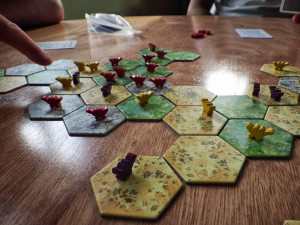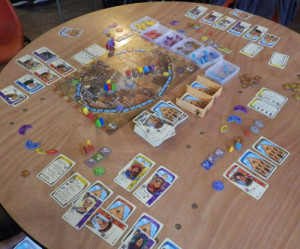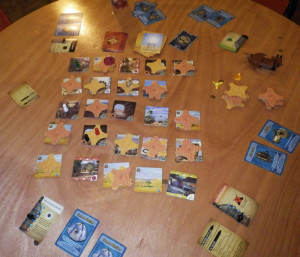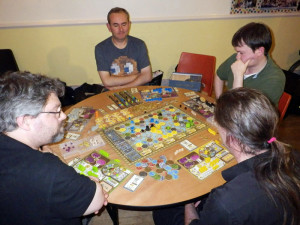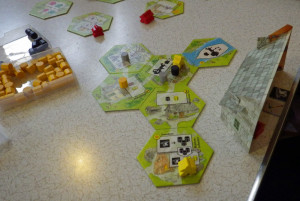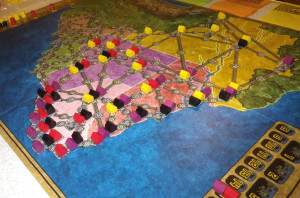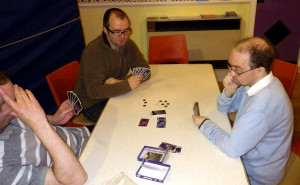(in which I attempt to re-start my regular blogging of things that happen at Newcastle Gamers meetings…)
10th of August was an all-day session, officially to celebrate the 100th meeting of Newcastle Gamers… but also, I suspect, because we were expecting a delivery of new tables for the club, and the delivery men don’t operate at night 
The new tables arrived very early … in fact, I hadn’t even settled on a first game to play when a slightly-confused van driver arrived at the door, so my first activity of the day involved helping Chairman John inspect & unpack the delivery (almost as much fun as un-boxing a new game. But not quite). Here’s a bunch of suspicious-looking characters playing an inaugural game of Love Letter at the first one we unpacked…
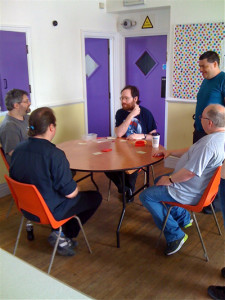
The tables are a pretty good acquisition… they seat 5 or 6 comfortably, and are better-suited for games which require a bit more 2-dimensional “spread” than the venue’s other (long and narrow) tables. Plus, with our ever-growing membership (we got 11 new people at this meeting), we’re starting to run out of available gaming surfaces. A few extra tables will save us from resorting to playing on the floor for that little bit longer 
Oh! This meeting also had one other special feature worth mentioning before I crack on with the customary list of games played… CHOCOLATE DICE!
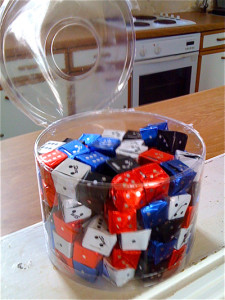
In celebration of our 100th meeting, some of the club funds had been invested in a supply of chocolate dice. They weren’t quite square, nearly always rolled a five, and some people insisted they tasted a bit cheap and nasty… but I liked them 
Anyway, on with the games…
Adel Verplicht (Hoity Toity)
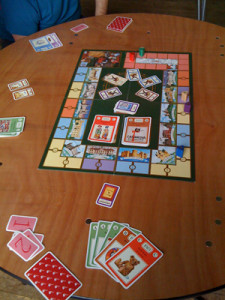
A game of aristocratic antique dealing and petty thievery… and winner of the Spiel des Jahres award way back in 1990.
Chairman John was keen to play this (it’s one of his all-time favourites), and I remembered having fun the previous (and only) time I tried it.
I was playing against some slightly more seasoned gamers this time around, and the difference in play style was quite notable; it was much more difficult to second-guess what actions people would take. I’m not sure that I enjoyed it quite as much as the first time I played — perhaps it didn’t have the novelty factor working in its favour this time, or maybe playing against unpredictable opponents made everything seems a little bit more luck-driven. Good fun, but I fear my interest might wane with a few more plays.
Next: Finstere Flure (Fearsome Floors)
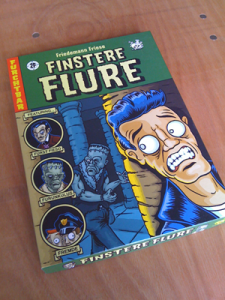
(Forgot to take a pic until it was all back in the box. Oops!)
Lunchtime was looming by this point, so I didn’t fancy getting into any 3-hour epics… I therefore suggested a game of Fearsome Floors. We played a 5-player game, which — perhaps surprisingly — played much, much faster than my previous 3-player Fearsome Floors experience at Newcastle Gamers. In the 5 player game, you only have 3 counters each (instead of 5), so there was the same number of counters on the board both times… but I guess the chaos level is just a bit higher when 5 different people are all trying to lure the monster in opposing directions. Plus, of course, you have to get fewer people out of the dungeon in order to win. It was a fun, light game… with a fair bit of banter and cries of anguish/frustration whenever a cunning plan turned out to be not-so-cunning. Good stuff.
Pandemic (base version)

Returning from lunch, I spotted a first-time visitor sitting alone at a table, clutching a copy of Pandemic (Camo’s, I think), and intently studying the rule book… so I thought I’d do the decent thing and introduce myself and offer to play! I managed to coral Dave and Chairman John (who, surprisingly, hadn’t played Pandemic before) into playing too, and the four of us promptly set about saving the world… on the easy level.
…Or not saving the world, as the case may be… 3 diseases cleared, but we were a long way off from sorting out the last one when the player deck ran out. Oh well… I think Babs (the newcomer) enjoyed the experience nevertheless 
Love Letter
We were getting pretty heavily besieged by newcomers at this point… a few of them were interested in trying out King of Tokyo, and Jerome offered to show them the ropes. I suggested Love Letter to the remaining people… working on the logic that both games would probably finish at around the same time, and we’d maybe be able to swap around a bit.
Unfotunately, not very far into the game, I completely forgot the names of everybody I was playing with. I suck with names at the best of times… it somehow seems even harder to remember them while also teaching games and keeping people on the right track. I therefore had to play the meta-game of “trying not to reveal that you’ve very rudely forgotten everybody’s names within minutes of being introduced” while playing my cards. I don’t think I did it very well. Sorry everybody 
Anyway, Love letter was a massive hit with the group… the sort of hit where everybody who played was asking how much it cost and where they could go and buy a copy. Result!
Village
As it turned out, King of Tokyo ran short, and Love Letter ran long… so the initial plan to have everybody synch up again after playing those two games fell by the wayside. The people on my table seemed keen to play something a bit longer/more board-gamey, so I suggested Village. I’d really brought it along with the intention of giving my copy of the Village Inn expansion another outing… but the plain vanilla version seemed like a good option to play with the new folks.
The game played out a bit differently to normal, with an unusually-high proportion of craftspeople meeting their maker very quickly (clearly, this particular Village had a bit of a gruelling work ethic!). This meant the crafting segment of the book of remembrance soon overflowed, and the game was pushed to an early close with the anonymous graves filling up with un-commemorated tradespeople. As such, it probably didn’t show the game at its best; this was probably one of the less-interesting games of Village that I’ve played … the new folks didn’t seem to mind though; they seemed to enjoy it.
People broke up a bit at this point for food, cigarettes, and to go and rescue cars from parking meters (somebody obviously didn’t see the mention of FREE PARKING on our web site!). I grabbed some sandwiches from the Sainsburys next door (it was around that time of day where all the freshly-made lunch stuff gets reduced – hooray!), and then hooked up with Les and James (who had just arrived) for…
(More) Love Letter
Again?
Yes, again.
Les and James had (amazingly!) never played Love Letter before, and we thought we’d play something short-ish since it looked like a bunch of other games were on the verge of completion.
And it is a neat game.
They were impressed. Really impressed. (I must’ve been instrumental in the sale of a bunch of copies of LL this week!).
Next up:
Terra Mystica
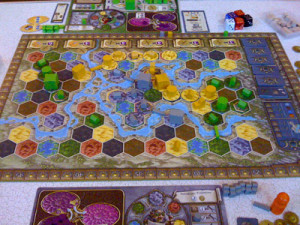
(This is the point where I remembered to start taking pictures again. Hooray!)
3 players, Me vs Les vs James (yep, yet again the old “let’s play something short, and somebody else is sure to be ending their game at around the same time as we finish” tactic didn’t work out quite as well as planned … so we settled down to a 3-way game of Terra Mystica).
Terra Mystica is a game which seems to have taken the BGG charts by storm this year… coming from pretty much out of the blue at the close of 2012, and ending up as the 8th highest-rated game on the site at the time of writing! I avoided it for a long time … from first impressions (admittedly, mostly from looking at pictures of the game materials), Terra Mystica struck me as a sort of Small world / Eclipse hybrid — two games that I’m not massively keen on. It’s got a bit of a high fantasy theme going on (Dwarfes, Halflings, Giants etc…), which I tend to find a bit harder to swallow than more traditional “euro game” themes. Plus, I’m kind of skeptical when comparatively expensive short-print-run games bubble up to the top of the BGG charts; I can’t help wondering if there’s an element of hype & purchaser-confirmative-bias involved in the ratings when such things happen.
Anyway, to cut a long story short… Terra Mystica is actually a very good game, and not at all the type of thing that I expected it to be… and while I wouldn’t say it was the 8th greatest game ever created, I certainly wouldn’t dispute that it’s amongst the 10 games that are most worth playing right now.
Let’s face it… when you see a game where each player controls a different fantasy race, and it has a big board covered in hex terrain, you automatically think it’s going to be some kind of pseudo-ameritrashy territory control game where you have battles and try to knock the stuffing out of each other, right?
Wrong. There’s actually no combat in this game. The many races (and/or factions) in this game are all living in peaceful co-existance, and trying to build the biggest cities. There’s a land-grabbing element, and a lot of strategy in making sure you get the prime real-estate before one of your opponents nips in and cuts off your expansion … but once you’ve claimed a hex on the board, it’s yours for good; No fisticuffs. No scrapping over ongoing ownership. It’s nothing remotely like a war game, and more of a network-builder / scoring race. And as such, far more my cup of tea.
The game does far too many clever things to detail here, but one of the more interesting aspects is the fact that there’s an action-selection mechanism involved, and this is driven by a set of tiles which you select randomly (from a larger set) at the start of each game. Each combination of tiles will present a different palette of options, and tilt the game to favour slightly different play styles.
The game has 14 different player factions (/races) to choose from, each with special powers and/or victory point generation routes, and with asymmetrical resource-generation “micro economies” of their own… and, obviously, different races suit different strategies and (therefore) different starting configurations. It’s an insane amount of stuff to explore.
This time around, I played the engineers. The engineers love to build bridges… they can build them easier than any other race, and for every bridge you erect, you get points at the end of every round. “Easy!” I thought… just rush-build some bridges and watch the points roll in! Of course, what I hadn’t reckoned for was the fact that engineers get a *far* smaller worker population than anybody else (I guess it takes longer to pass the bridge-building examinations), and — unlike all the other races — they don’t get a head start on any of the religion tracks in the game (another critical source of points) … leading to a very challenging, crunchy (and fun!) set of scarcity-driven resource allocation decisions through the game.
Meanwhile, Les was playing Nomads (they start with 3 cities on the map, instead of the usual two, and have a “sandstorm” power which turns the terrain bordering their cities into nomad-friendly desert), and James used the Witches (once they’ve built a stronghold they get a “witches flight” ability, which means a new witch settlement can pop up in a chosen forest hex every round, free of charge).
Sadly, I’d underestimated the amount of work I’d need to do on the religion side of things to keep up in the final scoring… (pesky atheist engineers!) and Les — who had been lagging behind for most of the game — zoomed ahead of me in the final round. …Which wouldn’t have been too much of a crushing defeat, except James had already secured a pretty good lead just by following the round-by-round building objectives (which are also randomly configured at the start of the game, and which I haven’t even talked about!). Still, our final scores weren’t too disparate, and it was a really enjoyable experience. Best game of the day 
Les and James had to head off at this point (On the way out, Les mentioned that we might not be seeing James so frequently in future, as he’s off to university next month.. Good Luck James!), so I went scouting around the room to see what else was going on. Olly looked like he was getting close to wrapping up a game of Agricola that he was involved with, and we’d (vaguely) pre-arranged to play Age of Industry at some point in proceedings, so I figured I’d nip to the shop for more munchies, then lurk around until they’d finished their game. John S (not me, the other John S) was also interested in playing, but only after he’d had chance to go to the chip shop… so while we were waiting, Olly and I played a couple of rounds of…
Coloretto
This game is a bit of an old one, but seems to have had a couple of outings at the club over recent weeks… prior to this resurgence of interest, I hadn’t played Coloretto for years, and I’d sort of forgotten what a neat game it is. It’s a simple set collection game — try to collect cards which are advantageous to you, while forcing your opponents to take cards which are disadvantageous to them. It’s quick, fun, and affords plenty of opportunity to do evil things to your opponents.
Olly hadn’t tried the two-player variant before… neither had I, but it’s very similar to the 2-player version of Zooloretto (which I’ve played a couple of times with Mrs Shep). Despite a feeling of vague familiarity, I played hopelessly badly; I’m clearly out of practice with this one, and need to get some extra-curricular games played… to this end, I’ve already scored a copy of the slightly-different-but-99%-the-same Coloretto – 10th Anniversary Edition to play at home 
Finally:
Age of Industry – Minnesota
Olly was keen to get his teeth into one of the more complex AOI maps (previously, he’d only played Germany, but he’s a big fan of AOI’s much-more-complex big brother, Brass). “Other John” hadn’t played AOI before, but is a pretty seasoned gamer, and didn’t mind being thrown in at the deep end… so we cracked open my previously-unplayed copy of AOI’s Minnesota Expansion:
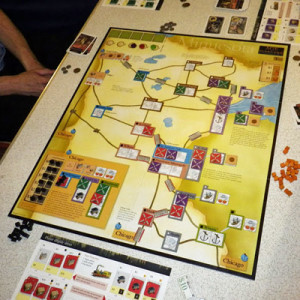
It’s an interesting map (though possibly a bit of an atypical introduction to AOI for first-time players, as it messes around with the base game’s resource production rules massively!). It has a significantly-modified coal-production system, you can use ships to export iron, certain cities offer hydro power for your industries (reducing the need for coal), there’s tweaked iron production rules in the Minnesotan iron ridge, and the map has some quirky/exploitable layout features like twin cities and potentially-valuable rail links into Chicago (coal city!).
Definitely the sort of map that takes a “learning game” before you get a grip on the strategic possibilities… but no worse for it.
I enjoyed this — I played a fair bit of AOI when I first got it, but then it kind of got sidelined by the Cult of the New … it was good to get re-aquainted with it. Especially since 4 new AOI maps have, apparently, arrived in the USA and should be hitting the board game geek store shortly (hmm… what was that I was saying about the Cult of the New?)
By the time AOI was back in it’s box, it was after midnight and I realised I’d clocked up 14+ hours of gaming. Time to call it a night.
* * * * * * *
A good day’s gaming… Highlight of the day was definitely Terra Mystica; I can see myself playing a lot more Terra Mystica over coming months, though AOI was pretty good too. It was also great to see a record number of new people at the club (the all-day sessions seem to be particularly good at bringing in first-timers!).
The next meeting is on the 31st August, starting at the more conventional time of 4:30pm. See you there!
Newcastle Gamers meets on the second and last Saturday of the month. Usual cost is £3 (or £1 for concessions), but your first visit is free … check our G+ group for more info.


 Follow
Follow
